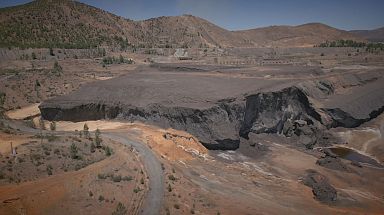The Rio Tinto mining park in Huelva Spain, is home to a unique touristic and educational initiative called "Mars on Earth". Established over 30 years ago as the leading industrial tourism destination in Spain, the mining park is perfect for space enthusiasts.
The Rio Tinto mining park in Huelva Spain, is home to a unique touristic and educational initiative called "Mars on Earth". The Mining Park, which has established itself over the last 30 years as the leading industrial tourism destination in Spain, has designed an innovative offer axed on educational tourism, perfect for space enthusiasts.
Learning about Mars
Opened on December 16th, visitors get to discover a russet landscape with crags and a red river that resembles Earth's sister planet Mars. This site is part of the European Valuetur project which promotes protected areas of high historical value in Spain and Portugal.
In this park, school children get to immerse themselves in a Mars research station or are even visited by curious astronauts in their classrooms. Part of the focus is on the mineralogical and landscape similarities with the red planet ... ideal for learning, according to Marina Santamaria, a teacher at the Virgen del Rosario school.
"You can really see the learning happen when students compare a reality with what they are working on in class," she says.
Realistic training grounds for Space agencies
For over twenty years, specialists from NASA, ESA and more have been coming regularly to Rio Tinto to study the subsoil and the acidic river. Within this valley, they also conduct tests on their equipment and prepare for their missions to Mars.
However, getting lift-off ready is not a space person’s only area of interest. Researchers have also taken a keen interest in the region where they have discovered a very special bacterium which could provide a solution to the question of oxygen production in space.
Aquilino Delgado Dominguez is the Mining Museum director, he says the Rio Tinto's ecosystem is very special.
"It has extremophile bacteria that consume iron, sulphur and then produce oxygen, unlike other animals living on Earth who consume it. If you already have the bacteria on Mars and the minerals to “feed” them, then you would have an oxygen factory and it would be easy for people to breathe. That is one of the things agencies are investigating."
The Tinto River
The Rio Tinto gets its name from its deep and characteristic reddish colour. This is due to a process called "weathering", which is a process in which minerals, when they come into contact with the biosphere, the hydrosphere or the atmosphere, degrade or fragment.
The water of the Rio Tinto is full of minerals such as iron and copper among others. When the molecules of these minerals come into contact with the water and dissolve, they generate this special colour.
These red waters have a pH between 1.7 and 2.7 with a high content of heavy metals, which means that there are no fish in this river. However, this does not mean that there are no living creatures in the Rio Tinto. The presence of oxygen allows some photosynthetic microorganisms, adapted to extreme habitats, to survive. Some species of fungi and mushrooms endemic to the river can also be found.
Investing in Sustainable Tourism- Feeding Hearts and Minds
The total budget for Valuetur is over 1.2 million euros, 77.9% of which comes from the European Cohesion Policy. Within this, the "Mars on Earth" initiative is valued at 300,000 euros, 75% of which is subsidized by Europe via the European Regional Development Fund.
In addition to the scientific component, "Mars on Earth" encourages the development of the local economy by associating local restaurants with this sustainable tourism project.
At the Casa Idolina restaurant, visitors can find a Martian menu: Rio Tinto cheeks, Martian rock croquettes, Martian scallops and a green cloud cheese cake.
Initially there will be a daily visit session from Wednesday to Saturday with a departure at 11 am. Given the characteristics of the circuit, the sessions will have a limit of 40 places.
The Rio Tinto Foundation's plan is to gradually increase the number of sessions, always guaranteeing compatibility with the other points of visit to the Mining Park, so that visitors can get to know the full offer of a unique tourist destination based on the recovery and use of the mining patrimony and the use of its natural resources.












